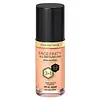Rimmel London Kind & Free Blur It Out Mattifying Skin Tint Versus Max Factor X Facefinity All Day Flawless 3 In 1 Foundation SPF 20
What's inside
What's inside
 Key Ingredients
Key Ingredients

 Benefits
Benefits

 Concerns
Concerns

 Ingredients Side-by-side
Ingredients Side-by-side

Water
Skin ConditioningDimethicone
EmollientZinc Oxide
Cosmetic ColorantCaprylyl Methicone
Skin ConditioningGlycerin
HumectantSilica
AbrasiveIsododecane
EmollientCetyl PEG/PPG-10/1 Dimethicone
EmulsifyingPEG-10 Dimethicone
Skin ConditioningCorn Starch Modified
AbsorbentNiacinamide
SmoothingPolysilicone-11
Triethoxycaprylylsilane
Kaolin
AbrasiveSodium Chloride
MaskingTocopheryl Acetate
AntioxidantBisabolol
Masking1,2-Hexanediol
Skin ConditioningCaprylyl Glycol
EmollientChlorphenesin
AntimicrobialDisteardimonium Hectorite
StabilisingPropanediol
SolventPropylene Carbonate
SolventCentella Asiatica Leaf Extract
Skin ConditioningNelumbo Nucifera Flower Extract
Skin ConditioningNymphaea Caerulea Flower Extract
Skin ConditioningPentaerythrityl Tetra-Di-T-Butyl Hydroxyhydrocinnamate
AntioxidantCI 77891
Cosmetic ColorantCI 77491
Cosmetic ColorantCI 77492
Cosmetic ColorantCI 77499
Cosmetic ColorantWater, Dimethicone, Zinc Oxide, Caprylyl Methicone, Glycerin, Silica, Isododecane, Cetyl PEG/PPG-10/1 Dimethicone, PEG-10 Dimethicone, Corn Starch Modified, Niacinamide, Polysilicone-11, Triethoxycaprylylsilane, Kaolin, Sodium Chloride, Tocopheryl Acetate, Bisabolol, 1,2-Hexanediol, Caprylyl Glycol, Chlorphenesin, Disteardimonium Hectorite, Propanediol, Propylene Carbonate, Centella Asiatica Leaf Extract, Nelumbo Nucifera Flower Extract, Nymphaea Caerulea Flower Extract, Pentaerythrityl Tetra-Di-T-Butyl Hydroxyhydrocinnamate, CI 77891, CI 77491, CI 77492, CI 77499
Water
Skin ConditioningCyclopentasiloxane
EmollientTalc
AbrasivePropylene Glycol
HumectantDimethicone
EmollientPhenylbenzimidazole Sulfonic Acid
UV AbsorberAluminum Starch Octenylsuccinate
AbsorbentSodium Chloride
MaskingPEG/PPG-18/18 Dimethicone
EmulsifyingPvp
Emulsion StabilisingMethicone
EmollientBenzyl Alcohol
PerfumingPhenoxyethanol
PreservativeSodium Hydroxide
BufferingEthylene/Methacrylate Copolymer
Synthetic Beeswax
Emulsion StabilisingTrihydroxystearin
Skin ConditioningSilica
AbrasiveSodium Benzoate
MaskingSynthetic Wax
AbrasivePolyglyceryl-4 Isostearate
EmulsifyingCetyl PEG/PPG-10/1 Dimethicone
EmulsifyingHexyl Laurate
EmollientIsopropyl Titanium Triisostearate
EmollientEthylene Brassylate
MaskingPolyethylene
AbrasiveCI 77891
Cosmetic ColorantCI 77491
Cosmetic ColorantCI 77492
Cosmetic ColorantCI 77499
Cosmetic ColorantWater, Cyclopentasiloxane, Talc, Propylene Glycol, Dimethicone, Phenylbenzimidazole Sulfonic Acid, Aluminum Starch Octenylsuccinate, Sodium Chloride, PEG/PPG-18/18 Dimethicone, Pvp, Methicone, Benzyl Alcohol, Phenoxyethanol, Sodium Hydroxide, Ethylene/Methacrylate Copolymer, Synthetic Beeswax, Trihydroxystearin, Silica, Sodium Benzoate, Synthetic Wax, Polyglyceryl-4 Isostearate, Cetyl PEG/PPG-10/1 Dimethicone, Hexyl Laurate, Isopropyl Titanium Triisostearate, Ethylene Brassylate, Polyethylene, CI 77891, CI 77491, CI 77492, CI 77499
Ingredients Explained
These ingredients are found in both products.
Ingredients higher up in an ingredient list are typically present in a larger amount.
This ingredient is a high molecular weight silicone. It has emulsifying and skin conditioning properties.
Ci 77491 is also hydrated iron III oxide. It's sole purpose is to give a red/pink hue to products.
Iron III oxides are classified as inorganic chemicals for coloring.
Synthetically created Ci 77491 is considered safer than those naturally found. This is because the synthetically created version may contain less impurities. Iron oxides are generally non-toxic and non-allergenic.
Learn more about CI 77491Ci 77492 is also hydrated iron III oxide. It's sole purpose is to give a yellow hue to products.
Iron III oxides are classified as inorganic chemicals for coloring.
Synthetically created Ci 77492 is considered safer than those naturally found. This is because the synthetically created version may contain less impurities. Iron oxides are generally non-toxic and non-allergenic.
Learn more about CI 77492Ci 77499 is also hydrated iron III oxide. It is created from mixing red and black iron oxides. This helps give shades of darkness to a product.
Iron III oxides are classified as inorganic chemicals for coloring.
Ci 77891 is a white pigment from Titanium dioxide. It is naturally found in minerals such as rutile and ilmenite.
It's main function is to add a white color to cosmetics. It can also be mixed with other colors to create different shades.
Ci 77891 is commonly found in sunscreens due to its ability to block UV rays.
Learn more about CI 77891Dimethicone is a type of synthetic silicone created from natural materials such as quartz.
What it does:
Dimethicone comes in different viscosities:
Depending on the viscosity, dimethicone has different properties.
Ingredients lists don't always show which type is used, so we recommend reaching out to the brand if you have questions about the viscosity.
This ingredient is unlikely to cause irritation because it does not get absorbed into skin. However, people with silicone allergies should be careful about using this ingredient.
Note: Dimethicone may contribute to pilling. This is because it is not oil or water soluble, so pilling may occur when layered with products. When mixed with heavy oils in a formula, the outcome is also quite greasy.
Learn more about DimethiconeSilica, also known as silicon dioxide, is a naturally occurring mineral. It is used as a fine, spherical, and porous powder in cosmetics.
Though it has exfoliant properties, the function of silica varies depending on the product.
The unique structure of silica enhances the spreadability and adds smoothness, making it a great texture enhancer.
It is also used as an active carrier, emulsifier, and mattifier due to its ability to absorb excess oil.
In some products, tiny microneedles called spicules are made from silica or hydrolyzed sponge. When you rub them in, they lightly polish away dead skin layers and enhance the penetration of active ingredients.
Learn more about SilicaChances are, you eat sodium chloride every day. Sodium Chloride is also known as table salt.
This ingredient has many purposes in skincare: thickener, emulsifier, and exfoliator.
You'll most likely find this ingredient in cleansers where it is used to create a gel-like texture. As an emulsifier, it also prevents ingredients from separating.
There is much debate on whether this ingredient is comedogenic. The short answer - comedogenic ratings don't tell the whole story. Learn more about comegodenic ratings here.
The concensus about this ingredient causing acne seems to be divided. Research is needed to understand if this ingredient does cause acne.
Scrubs may use salt as the primary exfoliating ingredient.
Learn more about Sodium ChlorideWater. It's the most common cosmetic ingredient of all. You'll usually see it at the top of ingredient lists, meaning that it makes up the largest part of the product.
So why is it so popular? Water most often acts as a solvent - this means that it helps dissolve other ingredients into the formulation.
You'll also recognize water as that liquid we all need to stay alive. If you see this, drink a glass of water. Stay hydrated!
Learn more about Water